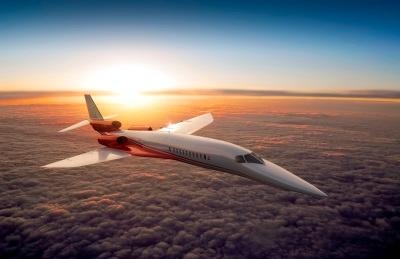Company Says The Plane Is 'Tailored To Emerging Global Demand'
Aerion Corporation on Monday introduced a larger configuration for the first in a family of supersonic business jets. The company is growing its technical organization and preparing to enter into industrial collaborations aimed at launching a new era of supersonic flight.

The Aerion AS2 retains a supersonic natural laminar flow wing, the key enabling technology behind practical and efficient supersonic and high-subsonic flight. The aircraft has a larger cabin, with cross-section dimensions roughly equivalent to those of today’s long-range business jets. It also has a trijet configuration that confers a number of benefits, especially for runway performance, external noise properties, and maximum range.
The new configuration draws heavily on worldwide operator input. “The message from many of today’s long-range business jet operators is very clear: They want a supersonic jet sooner rather than later; a cabin comparable in comfort to today’s long-range jets; a range of 5,000 nm or better; and they are willing to pay more than $100 million for such an aircraft," said Aerion CEO Doug Nichols. "That is the supersonic jet we are working to deliver.”
In the first quarter of 2014, Aerion completed its third market study in ten years to assess demand for a supersonic business jet, as well as the basic parameters of the most preferable configuration. That study, conducted by Rolland Vincent Associates, confirmed a consistent level of demand for more than 600 units over 20 years, although with a desire for a larger cabin and more range.
One difference from the earliest market research study in 2005 was the incorporation of on-line and face-to-face interviews from long-range jet operators based in markets around the world. The initial study surveyed mainly U.S. operators. “In the latest study, we analyzed a number of design trade-offs to determine the optimum aircraft,” said Vincent.
“We interviewed more than 130 operators of large cabin jets on-line and conducted 28 face-to-face interviews in the U.S., Europe, Middle East and Asia.”
“The bottom line,” according to Vincent, “is that the desire for supersonic transportation is steady and strong. The buyers are there. Their biggest question is, when can we have one?” Aerion’s answer is that such an aircraft would be available in about five years from a formal program launch with industrial collaborators in the aerospace industry. The company anticipates certification in or about 2021.
The Aerion AS2 is a three-engine jet and is larger than the originally conceived Aerion supersonic business jet. Fuselage length is 160 feet and maximum takeoff weight is 115,000 pounds. Minimum projected range is 4,750 nautical miles with the intention to achieve a range of more than 5,000 nautical miles.
The aircraft will have a 30-foot cabin in a two-lounge layout plus galley and both forward and aft lavatories, plus a baggage compartment that is accessible in-flight. Cabin dimensions widen from entryway to the aft seating area where height is six feet, two inches and cabin width is seven feet, three inches.
Balanced field length is 7,500 feet when fully fueled. The company expects that operators will be able to routinely operate at takeoff weights below 100,000 pounds while retaining trans-Atlantic and transcontinental U.S. capability, thus allowing the aircraft to operate from Teterboro as well as other major business aviation hubs with runways in the 5,000- to 6,000-foot range.

As with the smaller, original Aerion SBJ, the new aircraft will have two cruise “sweet spots,” where range and efficiency are at a maximum: one at about .95 Mach, for efficient cruise where supersonic flight is prohibited; and one at about Mach 1.4. At both speeds, total operating cost will be comparable to today’s largest ultra-long-range business jets. Maximum speed is Mach 1.6.
Aerion is in discussion with all leading engine suppliers to determine the optimum core engine for adaptation to supersonic requirements. The selected engine will be in the 15,000 lb. thrust range. The original Aerion supersonic business jet was to be powered by twin 19, 600 lb. thrust Pratt & Whitney JT8D engines. While a well-proven design, the JT8D originated in the 1960s. It had excellent characteristics for a supersonic jet (for example, its low bypass ratio), however Aerion subsequently determined that the engine was growth-limited. Moreover, newer, more efficient and more durable engines with lower emissions were preferable for the AS2 and follow-on aircraft.
The requirement to adapt a current engine core for the AS2 aircraft and to structure a joint collaboration among several industrial participants has led Aerion to elect to sponsor and finance the full-scale development program itself. “For program participants, we can take the financial risk largely off the table,” said Nichols. “We intend to make this program happen and, frankly, to maximize our return on investment. By assuming financial sponsorship of the program, we can accelerate commercialization of Aerion’s unique technology and intellectual property, and make practical and efficient supersonic flight a reality in just a few years.”
While discussions continue with potential partners, Aerion is proceeding with the advanced design of the AS2, including continued testing. It recently concluded a series of low-speed wind tunnel tests at the University of Washington Aeronautical Laboratory, assessing various high-lift flap configurations, and will conduct additional wind tunnel tests on other configuration elements in late May and early June. To date, Aerion has
invested over $100 million to develop proprietary enabling technologies and multidisciplinary optimization design tools to enable a renaissance of supersonic travel.
(Image provided by Aerion)
 ANN's Daily Aero-Linx (04.16.24)
ANN's Daily Aero-Linx (04.16.24) Aero-News: Quote of the Day (04.16.24)
Aero-News: Quote of the Day (04.16.24) Airborne 04.10.24: SnF24!, A50 Heritage Reveal, HeliCycle!, Montaer MC-01
Airborne 04.10.24: SnF24!, A50 Heritage Reveal, HeliCycle!, Montaer MC-01 Airborne 04.12.24: SnF24!, G100UL Is Here, Holy Micro, Plane Tags
Airborne 04.12.24: SnF24!, G100UL Is Here, Holy Micro, Plane Tags Airborne-Flight Training 04.17.24: Feds Need Controllers, Spirit Delay, Redbird
Airborne-Flight Training 04.17.24: Feds Need Controllers, Spirit Delay, Redbird




